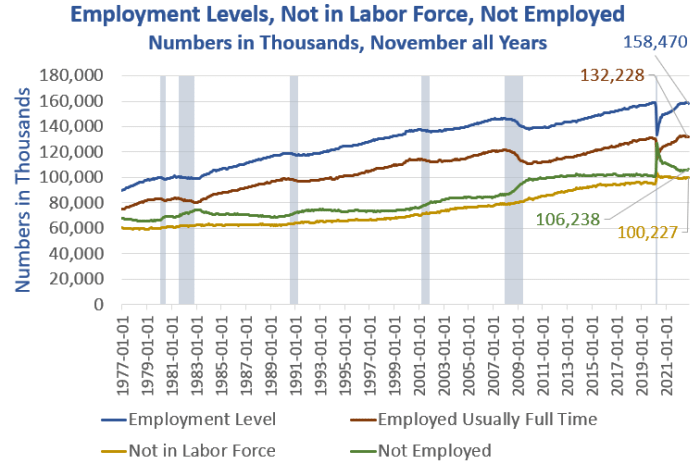The percentage of people age 16 and over who are not working is high and will get worse. Let’s go over why.
This article was originally published by Mish Talk.
Chart Notes
- Numbers are for those in the the Civilian Noninstitutional Population, defined as age 16 and over not in institutions (prison, nursing care, etc.).
- Employed means worked or paid for work (on paid vacation etc.), in the reference period.
- The labor force consists of all the people who are employed plus all of the people who are both actively looking for work and able to work.
- Not employed is not the same as unemployed.
- To be considered unemployed, you have to be actively looking for work and able to work.
- The number of unemployed is the the difference between not employed and not in the labor force, roughly 6 million.
Key Age 16 and Over Stats
- 158 million employed
- 132 million usually working full time
- 106 million not employed
- 6 million unemployed
Gotta love this stat: 106 million people age 16 and over are not employed but only 6 million of them are unemployed.
Employment Levels as Percent of Population
Chart Notes
- Population is the Civilian Noninstitutional Population (Age 16+)
- In the early 2000s, 64.74 percent were employed, only 59.87 percent today.
- In the early 2000s, 53.95 percent were employed full time, only 49.99 percent today.
- In the early 2000s, only 35.45 percent were not employed vs 40.13 percent today.
Key Idea
There is an increasing number of people who work to support those who are not working.
Many of those not employed are collecting Social Security, disability, and food stamps, now called the Supplemental Nutrition Assistance Program, SNAP.
Employment and Participation Rates by Age Group November 2022
I used seasonally-adjusted numbers when available otherwise unadjusted numbers.
Participation Rate Definition
The participation rate is the percentage of the population that is either working or actively looking for work.
The labor force participation rate is calculated as: (Labor Force ÷ Civilian Noninstitutional Population) x 100.
People are working or seeking work longer than ever but there’s a decline in the percentage of those in prime working age who are in the work force.
Where Are the Workers?
The Wall Street Journal asks Labor Market Mystery: Where Are the Older Gen Z Workers?
For people over age 15, the labor-force participation rate—the share of people employed or actively seeking a job—dropped from an average of 63.1% in 2019 to 61.7% in 2021, and recovered to 62.2% in October. But for people ages 20 to 24, participation that averaged 72.1% in 2019 stood at just 70.8% in October.
That equals a shortfall of about half a million workers in their early 20s when comparing the current size of that workforce with 2019 levels.
Participation for people over 55 also remains well below prepandemic levels. That seems at least partly due to many of them taking early retirement, either by choice or because of difficulty finding suitable work late in their careers.
Those reasons don’t apply to people in their 20s, who are usually just starting out in their careers.
In the past, a decline in labor-force participation among younger people has usually coincided with an increase in their school enrollment, generally reflecting higher relative demand for educated or highly skilled workers, especially in a weak labor market, economists said. That’s what happened during the 2007-09 recession—but it hasn’t been the case this time around. About 1.5 million fewer students were enrolled in college this fall compared with before the pandemic, according to the National Student Clearinghouse, an educational nonprofit.







